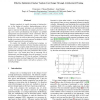Free Online Productivity Tools
i2Speak
i2Symbol
i2OCR
iTex2Img
iWeb2Print
iWeb2Shot
i2Type
iPdf2Split
iPdf2Merge
i2Bopomofo
i2Arabic
i2Style
i2Image
i2PDF
iLatex2Rtf
Sci2ools
71
Voted
MICRO
2007
IEEE
2007
IEEE
Effective Optimistic-Checker Tandem Core Design through Architectural Pruning
Design complexity is rapidly becoming a limiting factor in the design of modern, high-performance microprocessors. This paper introduces an optimization technique to improve the efficiency of complex processors. Using a new metric (µUtilization), the designer can identify infrequently-used functionality which contributes little to performance and then systematically “prune” it from the design. For cases in which architectural pruning may affect design correctness, previously proposed techniques can be applied to guarantee forward progress. To explore the benefits of architectural pruning, we study a candidate Optimistic-Checker Tandem architecture, which combines a complex Alpha EV6-like out-of-order Optimistic core, with some of the underutilized functionality pruned from its design, with a non-pruned EV5-like in-order Checker core. Our results show that by removing 3% of infrequently used functionality from the optimistic core an increase in frequency of 25% can be realized. ...
| Added | 16 Dec 2010 |
| Updated | 16 Dec 2010 |
| Type | Journal |
| Year | 2007 |
| Where | MICRO |
| Authors | Francisco J. Mesa-Martinez, Jose Renau |
Comments (0)

